Related Research Articles

Satureja is a genus of aromatic plants of the family Lamiaceae, related to rosemary and thyme. It is native to North Africa, southern and southeastern Europe, the Middle East, and Central Asia. A few New World species were formerly included in Satureja, but they have all been moved to other genera. Several species are cultivated as culinary herbs called savory, and they have become established in the wild in a few places.

Marrubium is a genus of flowering plants in the family Lamiaceae, native to temperate regions of Europe, North Africa, and Asia as far east as the Xinjiang region of western China. A few species are also naturalized in North and South America.

Fritillaria (fritillaries) is a genus of spring flowering herbaceous bulbous perennial plants in the lily family (Liliaceae). The type species, Fritillaria meleagris, was first described in Europe in 1571, while other species from the Middle East and Asia were also introduced to Europe at that time. The genus has about 130–140 species divided among eight subgenera. The flowers are usually solitary, nodding and bell-shaped with bulbs that have fleshy scales, resembling those of lilies. They are known for their large genome size and genetically are very closely related to lilies. They are native to the temperate regions of the Northern hemisphere, from the Mediterranean and North Africa through Eurasia and southwest Asia to western North America. Many are endangered due to enthusiastic picking.

Ajuga, also known as bugleweed, ground pine, carpet bugle, or just bugle, is a genus of 40 species annual and perennial herbaceous flowering plants in the Ajugeae tribe of the mint family Lamiaceae, with most species native to Europe, Asia, and Africa, but also two species in southeastern Australia. They grow to 5–50 cm tall, with opposite leaves.
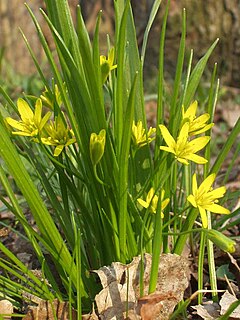
Gagea is a large genus of spring flowers in the lily family. It is found primarily in Eurasia with a few species extending into North Africa and North America.
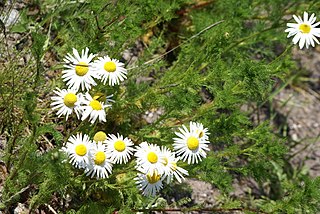
Tripleurospermum is a genus in the chamomile tribe within the sunflower family. Mayweed is a common name for plants in this genus.
The Koninklijke Algemeene Vereniging voor Bloembollencultuur, translated from Dutch as the Royal General Association for Bulb Culture, but more commonly known world-wide by the acronym of KAVB, is a trade association for the bulb horticulture sector, and was established in 1860. The association has a rural organization, within which regional groups and departments are active.
Colpodium is a genus of plants in the grass family, native primarily to Asia but with a few species on certain mountains in Africa.

Fritillaria uva-vulpis is a bulbous perennial plant belonging to the genus Fritillaria and native to eastern Turkey, north-western Iraq and western Iran. They are mainly found in the wooded foothills of the Zagros, where they grow in damp meadows and cornfields between 900 and 1800 m above sea level.

Eremurus is a genus of deciduous perennial flowers, also known as the foxtail lilies or desert candles. They are native to eastern Europe and temperate Asia from Turkey + Siberia to China.

Fritillaria graeca is a European plant species in the Lily family, Liliaceae. It is native to the Balkans. Some older literature says that the plant can also be found in Serbia, but all these collections are of var. gussichiae, now regarded as a distinct species called Fritillaria gussichiae.
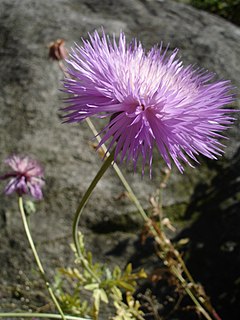
Amberboa is a genus of flowering plants in the daisy family, described as a genus in 1832.

Notholirion is a small Asian genus of bulbous plants in the lily family, Liliaceae. It is closely related to Lilium, but each individual flowers only once, and then dies after producing offsets. The bulb is covered by a tunic. Leaves are basal, produced in autumn and winter.
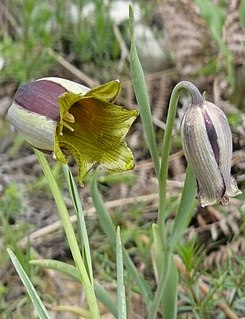
Fritillaria acmopetala, the pointed-petal fritillary, is a species of flowering plant in the lily family Liliaceae, native to rocky limestone mountain slopes in the Middle East. It was first described by Pierre Edmond Boissier in 1846.
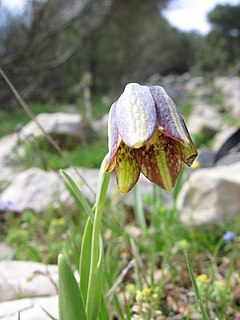
Fritillaria crassifolia is a Middle Eastern species of bulb-forming plants in the lily family Liliaceae. It is native to Iran, Iraq, Turkey, Syria, and Lebanon.

Fritillaria karelinii is an Asian species of herbaceous perennial plant in the lily family, native to Kazakhstan, Kyrgyzstan, Tajikistan, Uzbekistan, Turkmenistan, Iran, Pakistan, and Xinjiang.

Fritillaria meleagroides is a Eurasian species of bulb-forming plants in the lily family, native to Xinjiang, Russia, Kazakhstan, Ukraine, and Bulgaria.
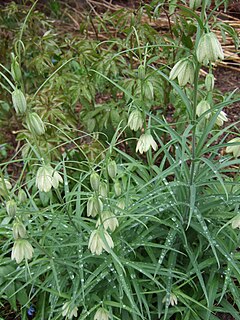
Fritillaria thunbergii is an Asian plant species of the lily family. It is native to Kazakhstan and in Xinjiang Province of western China, though cultivated in other places and naturalized in Japan and in other parts of China.

The taxonomy of Tulipa places the genus in the family Liliaceae, and subdivides it as four subgenera, and comprises about 75 species.